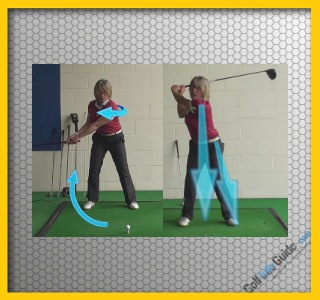3 of 5 | < Previous Next >

Now that you have evaluated your current swing, it is time to get to work making the needed changes to improve your ball flight. Of all of the golf tips driver swing plane is one that you should pay particular attention to because it has a profound influence on the ball flight that you will end up with. The golf driver swing plane should be flatter than that of your iron swing because you don’t want the club to take a divot out of the ground – you want the driver head to just brush along the top of the grass, if it touches it at all.
The first step in achieving a flat swing plane with your driver is to make sure you have a good posture for hitting a tee shot. The proper golf driver swing is a rotational swing that has your center of gravity remaining mostly in the same place throughout the swing. To set up for that kind of swing, make sure you have a good amount of flex in your knees, and keep your back straight. The worst thing you can do in your posture before a driver swing is to hunch over – that will put your shoulders on a plane that is too steep and will likely lead you to a slice. In fact, if you notice that you are fighting a slice with your driver, the first thing you want to check is your posture. Straighten out the position of your back and try to stand more upright at address. There is a good chance that just that adjustment alone will quickly straighten out your ball flight.
With your posture in a good position, the next part of the equation to deal with is the takeaway. This is another point in the golf swing where the plane can go all wrong. Many golfers use their hands too aggressively during the takeaway, especially with the driver. If you feel like you are trying to hit the driver as hard as you possibly can, there is a good chance your hands are working too hard at the start. When the club begins to move away from the ball, your hands should be doing very little – if anything. It should be your torso and your shoulders that generate the initial movement in the swing, while the hands just hold on to the club and remain quiet. Only once you get about halfway through the backswing should your hands do anything at all when they start to lift the club and hinge up toward the top of the backswing.
It is easy to check your top of the backswing position to make sure you are on the right plane to hit a quality driver shot. All you will need is a mirror that you can use to look at your swing, or a friend to take a look at it for you. Either way, make a backswing up to the top of the swing and then pause there. What you are looking for is the relationship between your lead arm (left arm for a right handed golfer) and the angle of your shoulders. Ideally, your lead arm will be pulled across your chest on a very similar plane to that of your shoulders. If you see that your arm is on a much steeper plane, you have the club too high up in the air and your swing plane will be too steep to hit your driver. When this is the case, work back through your swing and figure out when you got off track. It shouldn’t take long to locate the point in your swing where you got the club moving too much up instead of around.






